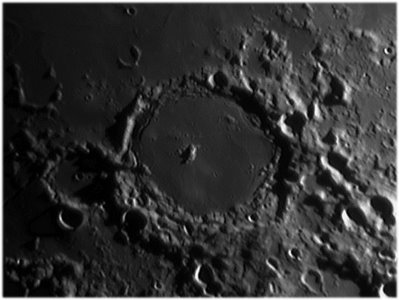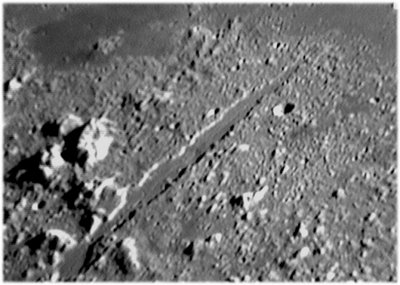 Pitatus is an ancient lunar impact crater located at the southern edge of Mare Nubium. Joined to the northwest rim is Hesiodus crater, and the two are joined by a narrow cleft. To the south lie the attached Wurzelbauer and Gauricus craters.
Pitatus is an ancient lunar impact crater located at the southern edge of Mare Nubium. Joined to the northwest rim is Hesiodus crater, and the two are joined by a narrow cleft. To the south lie the attached Wurzelbauer and Gauricus craters.The complex wall of Pitatus is heavily worn, and has been encroached by lava flows. The rim is lowest to the north, where the lava almost joins the Mare Imbrium. Near the middle is a low central peak that is offset to the northwest of center. This peak only rises to a height of 0.5 km.
Pitatus is a floor-fractured crater, meaning it was flooded from the interior by magma intrusion through cracks and openings. (See also the Gassendi and Posidonius craters for similar features.) The flooded crater floor contains low hills in the east and a system of slender clefts named the Rimae Pitatus. The larger and more spectacular of these rilles follow the edges of the inner walls, especially in the northern and eastern halves. The floor also contains the faint traces of deposited ray markings.
Just to the north of Pitatus in the neighboring maria is the half-buried rim of a lesser crater, covered in the past when Mare Nubium was formed.
 Vallis Alpes (latin for"Alpine Valley") is a spectacular lunar valley feature that bisects the Montes Alpes range. It extends 166 km from the Mare Imbrium basin, trending east-northeast to the edge of the Mare Frigoris. The valley is narrow at both ends and widens to a maximum width of about 10 km along the middle stretch. The selenographic coordinates of this feature are 48.5° N 3.2° E.
Vallis Alpes (latin for"Alpine Valley") is a spectacular lunar valley feature that bisects the Montes Alpes range. It extends 166 km from the Mare Imbrium basin, trending east-northeast to the edge of the Mare Frigoris. The valley is narrow at both ends and widens to a maximum width of about 10 km along the middle stretch. The selenographic coordinates of this feature are 48.5° N 3.2° E.The valley floor is a flat, lava-flooded surface that is bisected by a slender, cleft-like rille. (This cleft is a challenging target for telescope observation from the Earth.) The sides of the valley rise from the floor to the surrounding highland terrain, a blocky, irregular surface. The southern face of the valley is straighter than the northern side, which is slightly bowed and uneven. The more rugged edges of the valley lie at the narrow west-southwest end that cuts through the mountain range. Most likely this valley is a graben that was subsequently flooded with magma.
This valley was discovered in 1727 by Francesco Bianchini.

